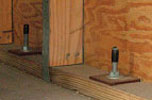Quick Terms Reference
Foundation - This is a perimeter of cement that supports the house.
Crawl space - This is the space between the ground under the house and the floor you walk on. Often the cripple wall and foundation creates this space.
Floor - This is the area you walk on that is above the sill plate or basement.
Sill plate/Mudsill - This is the layer of wood that rests on top of the foundation. The entire weight of the house rests on this layer and it should be secured to the concrete foundation. This is not the case in an older home and in an earthquake the entire sill plate could slide causing the house to fall off the foundation.
Cripple Wall - Not all homes have a cripple wall. This wall is the support between the sill plate on the foundation and your floor. It is often used to raise the house off the ground and foundation creating the crawl space. In older homes the cripple wall is not properly reinforced and in an earthquake the horizontal motion will cause the cripple wall to rock back and forth like a domino ultimately causing it to topple over bringing the house crashing to the ground.
 To survive an earthquake your home must be securely bolted to its foundation. more »
To survive an earthquake your home must be securely bolted to its foundation. more »
 NAVIGATION
NAVIGATION Many older homes have masonry foundations, character walls and chimneys that are not reinforced. By themselves, bricks and concrete blocks cannot handle horizontal forces and need to be reinforced in order to provide integrated stability to avoid collapse.
Many older homes have masonry foundations, character walls and chimneys that are not reinforced. By themselves, bricks and concrete blocks cannot handle horizontal forces and need to be reinforced in order to provide integrated stability to avoid collapse.